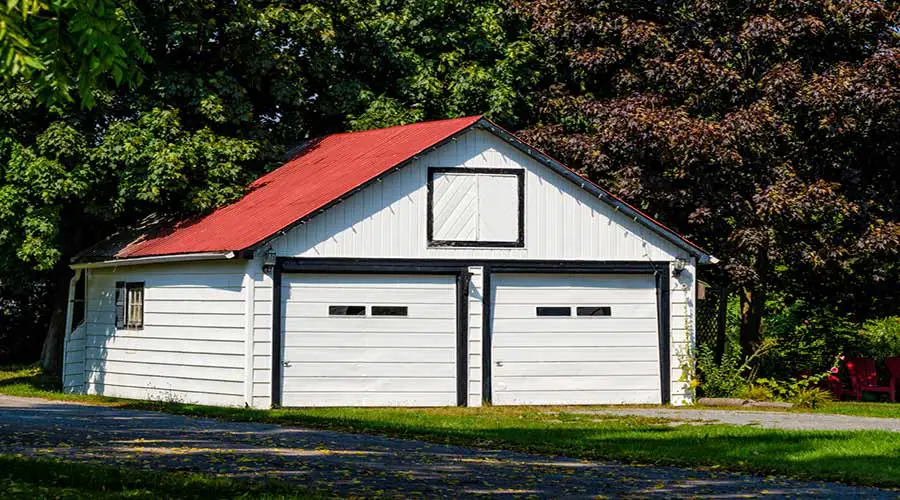
Foundation footings are a critical component of any structure. However, many garages do not need footings. Several factors go into whether your garage needs footings.
Basic garage structures are not required to have foundation footings unless your lot slopes or has poor soil conditions. Most garages have a 4″ inch poured concrete slab-on-grade, and the structure is built directly on the slab. A perimeter footing is needed to support more complex garage structures, such as a garage with a second story. Garages built on a slope will often need a raised reinforced concrete slab with footings.
What Does a Footing Accomplish?
Footings are essentially a support for the building to keep it from settling as the dirt in the area changes. Those changes can be due to poor soil or perhaps the freeze/thaw cycle.
In most cases, any footings required according to local building codes are constructed out of concrete and reinforced with rebar. They support the foundation of the garage and keep it from settling unevenly.
You should check with local building codes before building a garage or delivering a prefab garage to your property. More than likely, you will also be pulling building permits at this time.
The code enforcement in your area will leave no doubt in your mind as to whether you need a footing for your garage or not. Even if it isn’t required, it still is something to consider because it can add to the longevity and security of your garage.
A footing prevents the garage from settling. It does so by offering numerous benefits, including the following:
- Shore up Foundation: The footing will keep the garage foundation, typically a concrete slab, from settling. A more stable foundation results in fewer cracks or upheaval of the concrete floor.
- Support the Walls: This is where the rubber meets the road. The walls put most of the weight on the surrounding soil, and footings help to support them. Footings keep the structure from sinking over time.
- Even Settling: Although a well-poured and placed footing will keep the garage from settling, it will not stop all settling from occurring. The real key is to keep the garage from settling unevenly.
- Good for Problem Soil: If you live in an area where the soil is problematic and can shift under the weight of a garage, then a footing will help prevent it from happening.
- Cold-Weather Climates: Do you live in an area where a freeze occurs every year? The freeze/thaw cycle can lead to the settling of the garage. The footing gets under the frost line, stopping this from happening.
One factor to consider is the type of garage you are building. These garage structures will likely require foundation footings:
- Garage built on a slope greater than 10 degrees
- Garages with a second floor living area
- Any garage built where local building codes require footings
There is a big difference between an attached garage and a detached garage.
The differences in those two types of structures dictate the need for a footing in some cases.
Keep the following factors in mind when you are working with these two distinct types of garages.
Do You Need a Footing for An Attached Garage?
Numerous factors will make a difference in the need to have footings for any garage. At times, breaking things down to their most simple level can allow you to decide the start.
If you are building an attached garage, then a footing is likely going to be necessary. Any settling that takes place by the newly built garage can affect and even damage the existing structure.
If a footer is necessary for an attached garage, you may need to contact an engineering firm to assist. They can help to determine what type of footing to dig.
The first step will always be contacting the local building authority to find out what the building code requires. The building authority will let you know if a footing is needed or not.
Local Building Codes
In addition, the local building authority will let you know what is necessary as far as your footings are concerned. Some specifics could include the type of footing, how deep it is, and how much concrete to pour.
They create local building codes after considering various soil-related and geotechnical features in the local area. Some deciding factors could include the existence of annual frost or a hard freeze in that location.
Garage Settlement
When the ground freezes and thaws, it creates an unstable surface for your garage. The garage could have an uneven settlement. Uneven settling leads to cracked concrete floors and other issues.
The overall goal of footings is to keep the garage from settling unevenly. Some settling will occur, but if it settles evenly, there will be fewer problems.
One other factor to consider is the possibility of getting a contractor involved. They can help you with every step along the way, from deciding what type of footing to dig to completing the work.

Do You Need a Footing for A Detached Garage?
There is often more leniency when building a detached garage in comparison with building an attached garage. That doesn’t mean, however, that footings are not necessary.
As is the case with any building project taking place on your property, reference local building codes before the date of construction. You would also need to pull the proper permits. If you neglect to pull permits, you might face fines and other issues.
For a standard garage in most areas, it is not necessary to have a footing. A small, one-bay garage may do just fine on a gravel pad or a concrete slab.
There are differences in what a gravel foundation and a concrete slab have to offer. Here are some things to keep in mind.
- Gravel Foundation: This option is best for prefab sheds garages that come with a wood floor already constructed.
- Concrete Slab: A concrete slab is typically a good choice for a prebuilt garage that does not have a prebuilt floor. In this case, the concrete slab becomes the floor.
We already discussed the need to consider the type of soil and the weather in determining if you need a footer or not. Even if a footing isn’t a local requirement, it may be beneficial to have one.
Always think about the size of the structure. If you are building a large shed or having a prefab shed delivered, it’s not a big deal to put it on gravel or concrete.
On the other hand, larger garages would require footings. The larger size could include garages with multiple bays or a second story.
It’s not so much the size of the building, but rather, it is the weight of the building. Large garages will be heavier, and it will place more stress on the slab. It may last for many years, but the slab will likely suffer from cracks and other issues.
How Deep Does a Footing Need to Be for A Garage?
You could always hire an engineer to tell you exactly how deep the footings must be for your local area, but it is much less expensive and easier to check with the local building codes.
The depth, width, and other factors associated with the footing will differ from one area to another. Those changes make it necessary to check with the local building authority. Changes may even be seen from one property to another within the area.
One factor that determines how deep a footing needs to be is the frost line. Your local building authority can give you information as to where the frost line is.
Why is that good to know?
Anything from the frost line above to the surface of the ground will be unstable throughout the year. As the ground freezes and thaws, sometimes multiple times per year, it will allow the structure to settle.
You must get well below the frost line to offer a stable foundation for the garage. Typically, this will be 18 inches below the frost line and at least that far below any undisturbed topsoil.
Do you live in an area with a heavy freeze?
If so, there is another consideration for digging a footing. It has to do with safety and regulations that govern how to dig a trench.
If you are digging a small footing for a garage, you can do so by hand with a pick and shovel. On the other hand, a deep trench for a foundation has dangers that could include a cave-in.
Some areas will dictate digging trenches, including benching or using something to shore up the sides. It will be necessary for those areas when you pull your permit.
An engineering firm can help you determine what type of changes are needed in the footing if you run into difficult soil.
Does a Garage Slab Require Rebar?
In many areas, rebar is not a requirement for a concrete slab. That doesn’t mean that you should overlook the possibility of including rebar because it offers many benefits.
Some contractors don’t require the use of rebar if it is not part of the local building code. When it isn’t a requirement, it becomes a personal choice, and it is one that you should take part in if it becomes an issue.
An example of this would be pouring a reinforced slab to park an RV, Semi-trucks, or other heavy equipment. These vehicles can cause a slab to crack under the weight. Often, these slabs are 6 inches or greater and reinforced.
A concrete slab can experience significant difficulties if it is not prepared and poured correctly. Rebar is a reinforcement for the concrete, helping to hold it together and keeping it from shifting and cracking when anything settles underneath it.
If you prepare the area under the concrete correctly, it may not be necessary to support the slab using rebar. It would also need enough expansion joints to keep the concrete from cracking or heaving.
Even if rebar is not a requirement for a concrete floor in your area, it will still provide support. Once you pour the concrete, you can not go back and add the rebar later.
What About a Second Floor Over the Garage
A footing will almost always be required when building a garage with a second floor.
Generally, you pour perimeter footings to support the weight of the framing and roof. The footing is there solely to support the structure. You then pour the garage slab separately.
Suppose you pour a raised concrete slab for the entire garage; you’ll need footings and a reinforced slab.
A raised concrete slab needs to be higher in the back to create a level surface on sloped land.
Can a Garage Floor Be the Same Level as The House?
The garage floor elevation is not typically an issue with a detached garage. For an attached garage, however, it is something to consider.
As is always the case, check with local building codes. Many older homes have garage floors that are lower than the finished floor of the living space. Typically, a 4-inch differential is present with concrete slab houses.
In most concrete slab-constructed houses, the garage slab is independent of the house foundation.
Houses with crawl spaces will nearly always have a garage that is lower than the living area.
There is nothing wrong with having a garage floor lower than the finish floor of the home. It boils down to aesthetics and the inconvenience of stepping up into the house from the garage.
Final Thoughts
As you can see, there is much to consider when it comes to the footings when building a garage. They may not always be necessary, but they will almost always be advantageous.
Even though you don’t see the footing, make sure you think long-term. It will help to keep your garage standing and trouble-free for many years to come.







